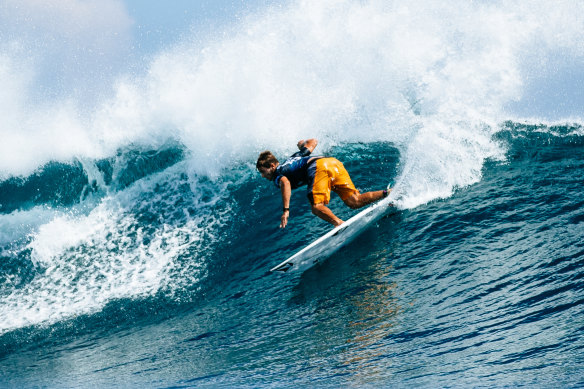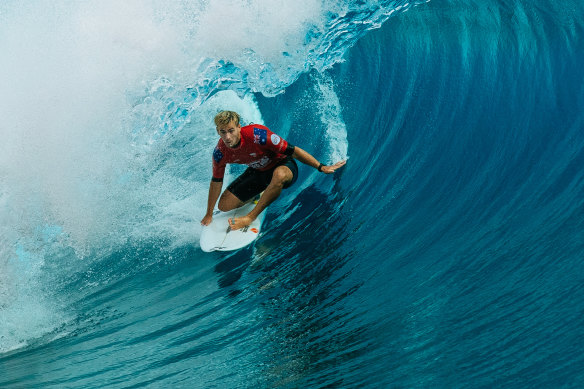Jack Robinson was 12 years old – with a glorious bleach-blond bowl cut – when he was dubbed the potential “Phar Lap of Australian surfing”.
Twelve years on, Robinson chuckles at the racing parlance, spawned when his dad Trevor said he was “hand-rearing a racehorse”.
Prodigiously talented, surfing some of the world’s heaviest waves (Pipeline in Hawaii, The Box in Western Australia) and sponsored by Quiksilver before he was a teenager, the hype was over the top, but not entirely unjustified.
Nor is Robinson’s take on it. Life is good. Relatively speaking, it always has been – even when sponsors drifted away and lift-off from the second-tier World Qualifying Series took longer than anticipated, courtesy of a fall outside the top 100 in 2017.
Now 24, life is better than ever. Robinson is No.2 in the world and based in California for surfing’s Melbourne Cup – the WSL’s winner takes all, one-day finals extravaganza at Lower Trestles – chasing Australia’s first men’s world title since Mick Fanning triumphed in 2013.
“It’s still the dream job, and you still come back to the fun of surfing,” Robinson tells The Age and The Sydney Morning Herald of a home-schooled childhood spent travelling the world, albeit in surfing’s limelight.
“People want to see it all happen straightaway, and after that they’ll see what they want to see.
“‘I’ll get there when I get there’, was how I tried to keep it all in perspective. You see a lot of the best athletes growing up in the spotlight and there were tough years there when you’re losing a lot and people are wondering why. You’re wondering why.
“But I think losing can be what makes great athletes. You remember what went wrong and you learn little bits and pieces from winning, but you learn a lot more from a loss.
“It’s weird to think how long I’ve been competing and trying to get here, because I feel like I’m only just getting started.”
“Learning” is a phrase Robinson returns to repeatedly. His formative years were guided by Trevor, at times to the chagrin of sponsors and types in the surfing industry.
“Eccentric”, “blustery” and “soccer dad” are terms used regarding Robinson snr’s approach, one rarely seen in competitive surfing.
Jack doesn’t shy away from the evolution in their relationship. He took charge of his career when he entered his 20s.
“It was a full-on few years there and I know it wasn’t the easiest thing to deal with for the sponsors at the time,” Robinson says.
“But we’re in a different chapter and all that’s in a really good place now. Growing up, seeing that happening, I think it happens with a lot of young athletes.
Jack Robinson dominating G-Land in Indonesia.Credit:Ed Sloane/World Surf League
“I’m pretty cool usually. Basically [the conversation] was, ‘it’s my time now, I’ll do my thing’.
“I think he was doing the best [he could] and what he thought was best for me. I grew up and saw what worked for me and said, ‘I’ll take the reins and take a hold of it from here’.”
Due to COVID disruptions, it is only the second year on the World Tour for Robinson.
He, third-ranked Ethan Ewing and women’s No.5 Steph Gilmore will fly the Australian flag at Trestles.
Robinson and Ewing are chasing world No.1 Filipe Toledo, a key figure in the “Brazilian Storm” that has seen his countrymen win all bar two of the men’s world titles since 2014.
Robinson’s Brazilian wife Julia Muniz, Brazilian coach Leandro Dora (a key figure in the nation’s surfing rise) and his son Yago (world No.19) make for a fine travelling crew alongside manager Matt Bemrose.
They’ve been crucial to Robinson’s ascent. He tossed a barb Toledo’s way via News Corp this week, questioning his half-hearted attempt to surf a heaving Teahupo’o last month given he already had pole position wrapped up.
“An event like that I know a lot goes through everyone’s heads when you see the No.1 guy go out there and not catch many waves,” Robinson said.
Robinson right at home in a heaving Teahupo’o barrel last month.Credit:Damien Poullenot/World Surf League
“I don’t know what was going on in his head. It’s probably a lot of pressure and a lot of things. It’s a different mindset [you need to have] in bigger waves and sometimes it takes a long time to get used to. It’s not something that crosses my mind.”
It’s a comment Robinson would not have made in previous years, not least because he wasn’t on the Tour.
Raised on big breaks, Robinson’s learning curve has been Toledo’s bread and butter – the smaller, “skatepark” style waves expected at Trestles in the next few days.
Where once the off-Broadway, smaller waves offered by the Qualifying Series left a younger Robinson “bored” and sometimes struggling for motivation, the challenge and competition are now approached in a new way.
“Learning on those big waves as a kid, the adrenaline’s there in the elements and the wave itself,” he says.
“Smaller waves, the fear factor isn’t there. It’s the competition that drives you and provides that adrenaline, and then it’s the technical aspects of surfing that way, where I think I’ve progressed since getting on tour.
“You always want to be learning about yourself right? That’s why we do anything.”
Twelve years after the bowl cut and his first big splash, Robinson may just be getting started after all.
Sports news, results and expert commentary. Sign up for our Sport newsletter.
Most Viewed in Sport
From our partners
Source: Read Full Article


